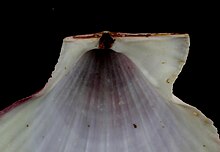Resilifer

A resilifer is a part of the shell of certain bivalve mollusks. It is either a recess (a pit or groove of some sort) or a process, the function of which is the attachment of an internal ligament, which holds the two valves together.
An internal ligament (which requires a resilifer to function) is part of the hinge mechanism in certain taxonomic families of bivalve shells, such as oysters and scallops.[1][2][3] A resilifer (and its associated ligament) is the primary structure comprising the type of bivalve hinge that is known as an "isodont" hinge.

References
- ^ Tutorial Bivalves State University of New York College at Cortland [dead link]
- ^ J.H. Leal. "Bivalves" (PDF). Florida, USA: Bailey-Matthews Shell Museum.
- ^ Dr. Burt Carter. "Invertebrate Paleobiology on-line syllabus on Bivalves". Georgia Southwestern State University. Archived from the original on 2020-02-25.
- v
- t
- e
Bivalve anatomy
- Callus
- Hinge line
- Hinge teeth
- Ligament
- Lira
- Lunule
- Nacre
- Pallial line
- Pallial sinus
- Periostracum
- Prodissoconch
- Resilifer
- Resilium
- Sculpture
- Umbo
- Valve
- Beak
- Annuli
- Adductor muscles
- Ctenidium
- Gastric shield
- Mantle
- Nephridium
- Siphon
 | This bivalve-related article is a stub. You can help Wikipedia by expanding it. |
- v
- t
- e










